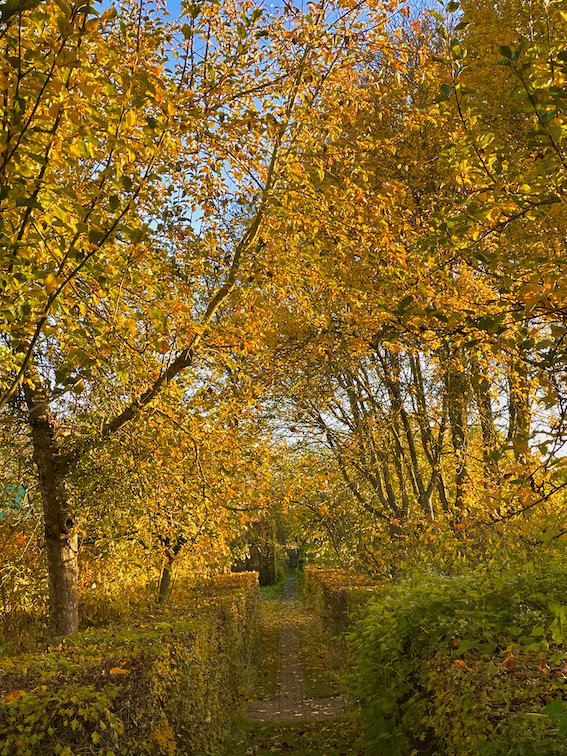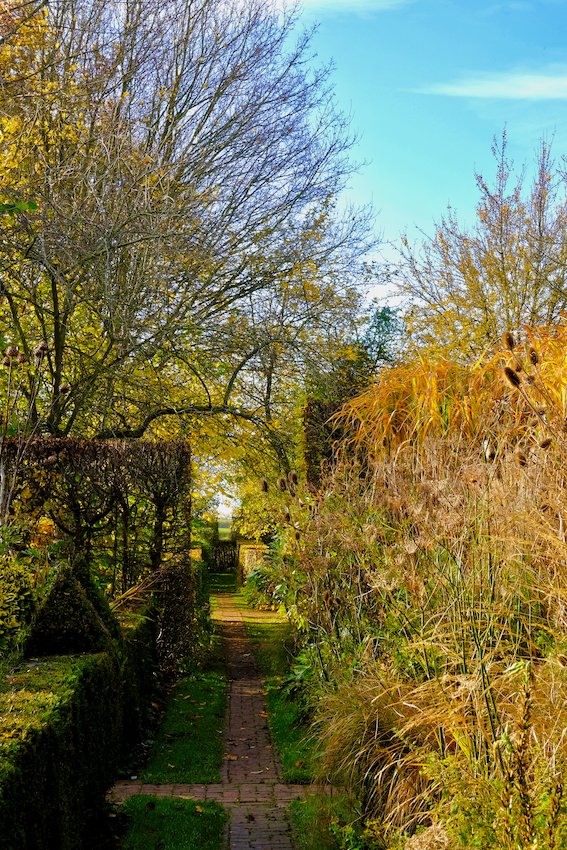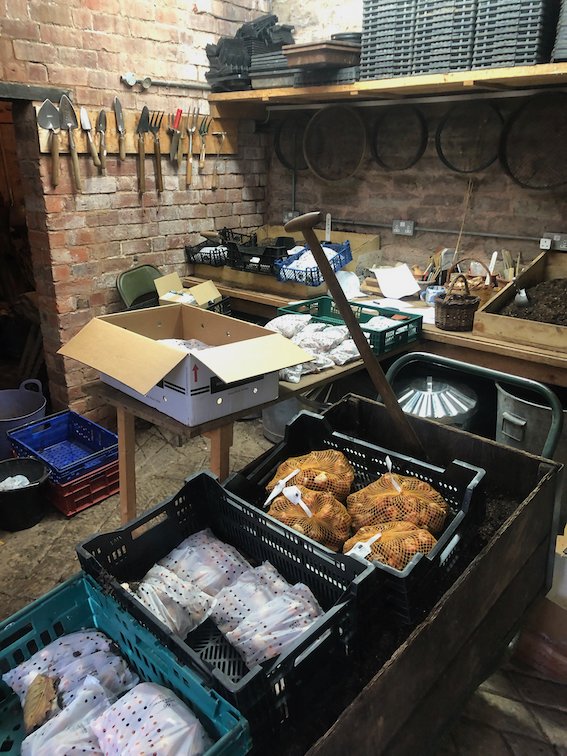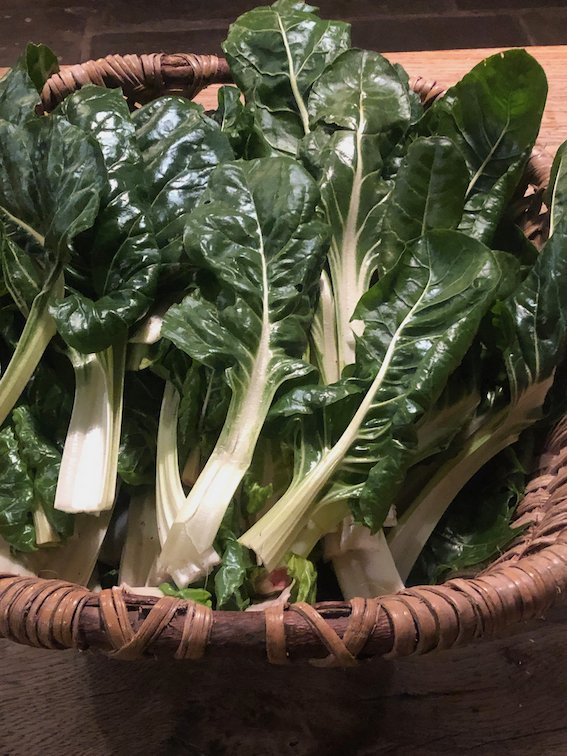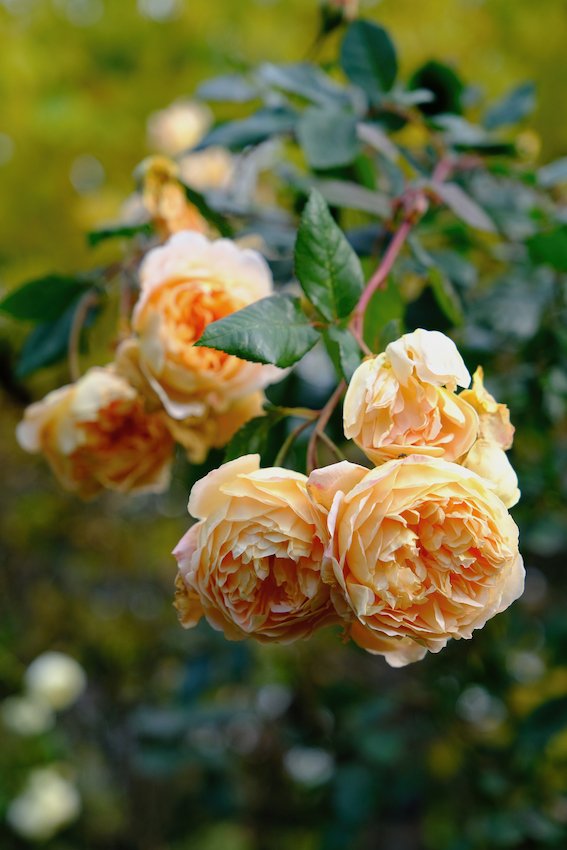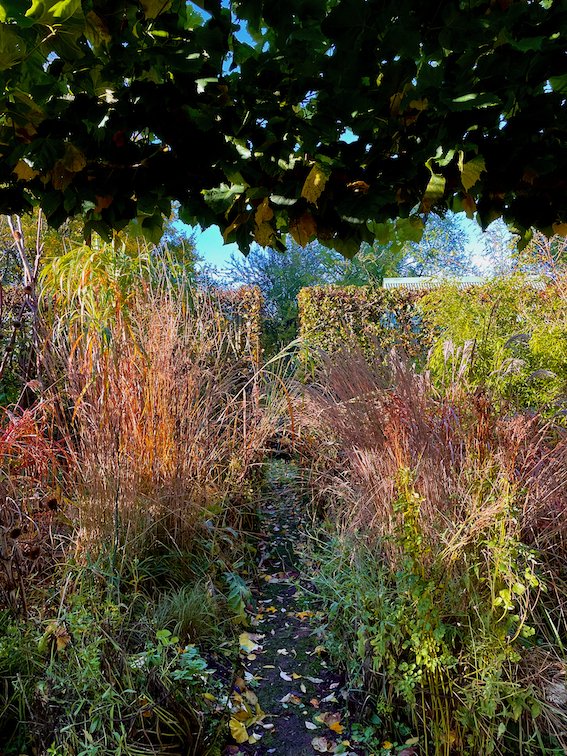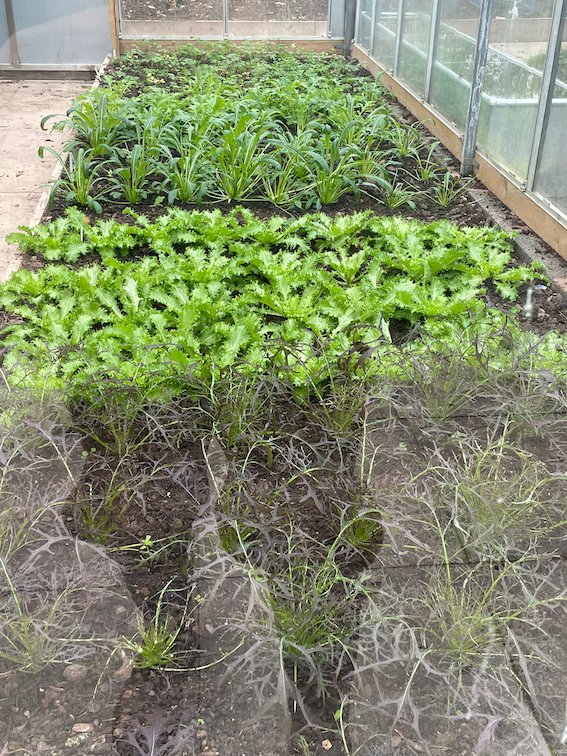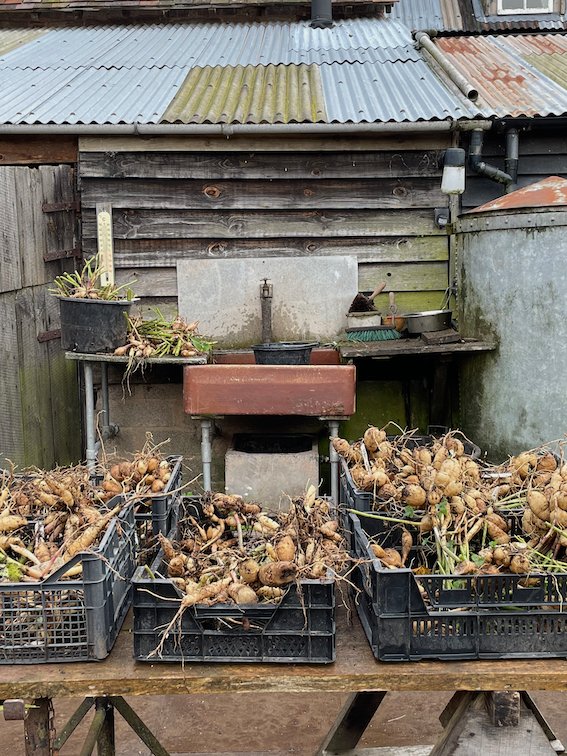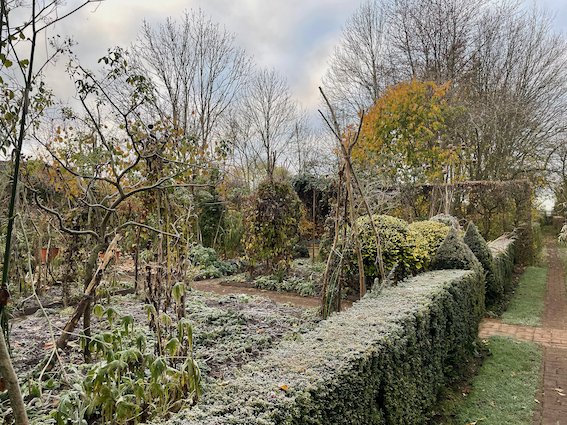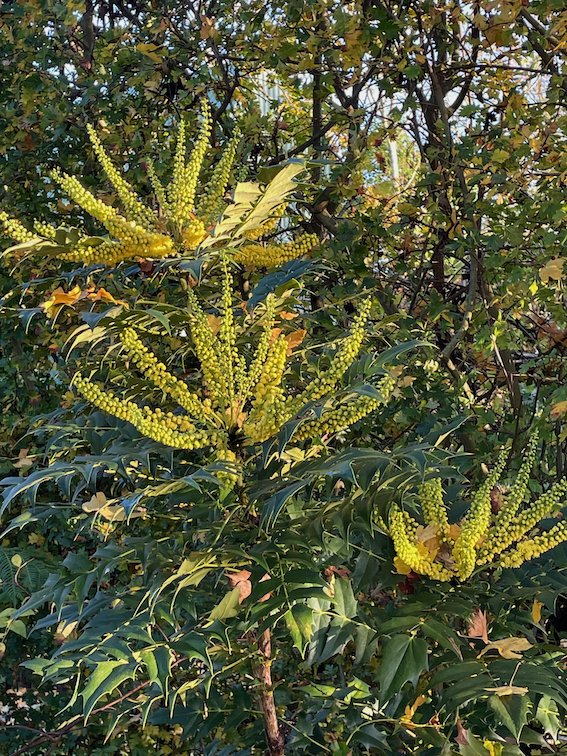November 2022
This autumn has again been exceptionally mild with the weather more akin to April or even May. This, of course, is part of the trend caused by climate change and we should expect and be used to it but it is shocking, disturbing and frightening in equal measure.
Even ten years ago we would bring in all our tender plants such as cannas, dahlias, salvias, bananas and gingers by the middle of October in the confident expectation of a number of quite sharp frosts before the end of the month.
Now we could have to wait for December for that cold spell and the garden - and gardener - is having to adapt.
The upside is that roses are still blooming, we have a sustained second flowering of delphiniums and the Jewel Garden still zings with zinnias, tithonias and helianthus.
However, here in the northern hemisphere, the unseasonable heat cannot alter the falling light. The days are now short and often cloud-covered and gloomy.
British Summer Time went back an hour at the end of last month and it is dark as I write this by 5.30 and in a few weeks time will be too dark to garden outside by 4.30.
Hot or cold, winter's bleakness draws inexorably in.
So we gradually put the garden to bed. Tender plants are protected, leafy perennials cut back, furniture brought in ready for repair and repainting, garden machinery checked over and serviced and the horticultural hatches battened down.
But there is planting too. November is a very good month for planting trees, shrubs, hedges and perennials. It is also the perfect time for tulips whether in pots or in the ground.
Filming Gardeners' World has finished until early next Spring and I am making a tour of the UK this November talking about the garden, life and quite a lot of dogs, so if you are able to join me at the location nearest you (see the events page) then do come along.
NOVEMBER JOBS
Leaves
Keep gathering fallen leaves, mowing them, keeping them damp and storing in a bay or bin bags to make leafmould. Leaves decompose mostly by fungal action rather than bacterial which means that dry leaves can take an awful long time to turn into the lovely, friable, sweet-smelling soft material that true leafmould invariably becomes. So either gather leaves when they are wet or be prepared to dampen them with a good soaking before covering them up with the next layer.
It also helps a lot to chop them up. The easiest way to do this is to mow them which also gathers them up as you do it. Of course if the leaves are too wet they will clog the mower up so I try and sweep and rake them into a line when dry, run the mower over them and then give them a soak with the hose when they are in the special chicken wire-sided bay. If you don’t have room for a dedicated leaf bay then put the mown leaves into a black bin bag, punch a few drainage holes in the bottom, soak them and let it drain and then store it out of sight. This system works perfectly well
Either way the leaves will quietly turn into leafmould over the next six months without any further attention. You can also use them in Spring in a half-decomposed state, as a very good mulch around emerging plants.
Plant Tulips
November it is tulip-planting time. This is, to my mind, the most important and best job of the month. It is actually something that can be done at any time between now and Christmas although the earlier they get into the ground the earlier they will flower.
The essential thing with all tulips is to make sure that they have good drainage. This matters less if they are to be treated as annuals and dug up after they have flowered but even so they will be happier with plenty of grit or sand added to heavy soil. If they are to be permanent it is important to plant them as deep as you can - II often use a crowbar to make a hole 12 inches or more deep - and the deeper they are the stronger and straighter the stem will be.
If you are growing them in a container then drainage is easier and they do not have to be so deep and can also be planted in layers - a tulip lasagne, with an earlier variety such as ‘Orange Emperor’ planted deepest that will flower first, followed by a mid-season variety like ‘Negrita’ planted above it and then finally, in the top layer a late-season one such as ‘Queen of Night’.
Lifting Dahlias
Frost reduce Dahlias to blackened tatters so it will be time to bring them in. However the tubers will not be harmed unless the ground freezes, so do not panic.
Wait until the top has fully died back and then cut back the top growth to 6 inches whilst they are still in the ground and carefully dig up the tubers, removing as much soil as possible. Stand them upside down for a few days to drain any moisture from the hollow stems and to let the tubers dry a little and then store them in a tray or pot packed with old potting compost, vermiculite, sharpsand or sawdust.
The idea is to keep them cool but frost-free, dark and dry but not to let them dry out completely or else the tubers will shrivel. I lightly water mine after layering them into large pots or crates and then check them every month to see if any are mouldy or shrivelling up.
Moving Plants
One of the benefits of climate change is that the autumnal soil stays warmer for longer and thus November is a very good time to move plants, from small trees to shrubs like roses or herbaceous perennials. If you are moving any plant there are a number of considerations although the larger the plant the slower it will be to adapt to its new home and the more careful you must be when moving it.
1. Water the plant very well 48 hours before moving. Give it a really good soak.
2. Dig as large a rootball as possible. For herbaceous perennials this should not be a problem - and you may well want to divide it into smaller sections before replanting - but for trees and shrubs this inevitably means cutting back the amount of roots.
3. Reduce the top growth to balance the amount of root you lift. Ideally the spread of a shrub or tree should not exceed the spread of the roots and with shrubs like roses cut them back very hard.
4. Replant carefully into well-dug soil so that the roots are at the same level in the soil. Firm it in very well and give a very generous soak.
Protect Tender Plants
Climate change has made our winters warmer and wetter. 25 years ago you could depend upon a spell of a week or so of sharp frost around the middle of November where the temperature would remain below freezing for days on end, but this is becoming increasingly unlikely. However the temperature can plummet very quickly indeed overnight and semi-tender shrubs like pomegranates, olive, bay or citrus grown in containers - which are healthiest kept outside as long as possible - can suffer real damage. The solution is to have squares of horticultural fleece cut to fit each plant ready to wrap around them. This will be enough protection against light frosts although in really cold weather, when the temperature drops below minus 5, they will need a double layer or moving indoors. I lightly secure them with twine so that the fleece is easy to remove as soon as the temperature rises again.
Tree Ferns
The tree fern, Dicksonia, is not reliably hardy although it is quite happy down to about minus 5. If you are really worried and have the space you can dig them up (they have minimal roots in the ground) and keep them in pots in a frost-free place until Spring. But there is no need to bring them in under winter cover if you protect them where they need protecting most.
The secret is to make sure that the central soft inverted cone at the top of the stem (it is not really a trunk as it is made up of rods of root) is unable to fill with water that can then freeze. The easiest way to do this is to pack it with straw which both insulates and acts as a sponge. I change this straw once or even twice during the winter. Then I bandaged a thick layer of fleece around the vulnerable top 6-9 inches of the stem to provide extra insulation. The leaves will die back anyway so need no care and the lower part of the trunk is not the crucial growing point, so this can remain unprotected too.
Washing Slippery Paths
At this time of year brick and stone paths can be very slippery and dangerous. This is due to algae that grows on the surface, especially if wet and shaded and at this time of year they may stay wet and slippery for months. The best way to reduce the slipperiness is to wash off the algae with a pressure hose (which can be hired by the day). When this is done brush in sharpsand. If the path is brick or stone the porous surface will absorb some of the sand. A quicker -but still quite laborious - alternative is simply to work sand in with a stiff brush without the washing. Either way you have a very effective way of making a path safe without resorting to chemicals.
Plant Trees, Hedges and Shrubs
Continue to plant deciduous wood material such as trees, hedges and shrubs. From the beginning of this month nurseries will be selling bare-root plants. Buying woody deciduous shrubs, hedging plants or trees ’bare-root’ - ie straight from the ground and not in a container - tends to be much cheaper, better quality and offers a much wider choice. But this must be planted when dormant so this is becoming a job that needs doing urgently. Plants in pots can wait a little longer if necessary.
As soon as you receive the plants give them a good drink in a bucket of water and keep them moist until ready to plant. Prepare your planting hole, remembering that a wide hole is much better than a deep one, and do not let the roots dry out even for a minute as the will die back very quickly so keep them covered or soaking in a bucket of water until the very last minute. Plant firmly, keeping all the stem above soil level, stake if necessary, water well and then always mulch thickly.
Planting Paperwhites For Christmas
Paperwhite daffodils, narcissi papyraceus, will be flowering for Christmas if you plant them at the beginning of November. Unlike most daffodils, it is native to the mediterranean and do not require a period of vernalisation - or cold - to induce flowering. So plant the bulbs just beneath the surface of your compost in a container ( ideally with drainage but a normal bowl can be used if you add some charcoal to keep the soil sweet) keep them watered but not soggy and place in a warm, light place. The bulbs will grow strongly and if indoors in the warmth flower in 4 weeks. To delay and prolong flowering keep them cool but frost free.
Hardwood Cuttings
Hardwood cuttings are easy to take, slow to grow roots but a remarkably straightforward way of creating new shrubs, bushes and even trees from existing favourites. Fruit bushes, roses, any flowering shrub or tree are ideal for this method of propagation. Unlike growing plants from seed, cuttings always ‘come true’ - in other words are exactly like the parent plant so it is the best way of reproducing favourite plants as well as being almost totally trouble free and needing no extra equipment or shelter.
Cut a 12-24 inch length of straight stem the thickness of a pencil of this year’s growth, and divide it into lengths between 6 & 12 inches long. Cut straight across the bottom and at an angle at the top so you remember which way up to plant it and to provide an angle for water to run off.
Strip any remaining leaves from it so you have bare, straight stems and either place the cuttings so only one third is above soil level in a deep pot filled with very gritty compost (4 or 5 can fit into each pot) or outside in a narrow trench backfilled with gritty sand to ensure good drainage. Leave them until next autumn, watering well once a week and a good percentage will make young plants ready for potting up or planting straight out.
Clean and Service Lawn Mowers
Rather than leaving it till you want to make the first cut of your lawn next spring, now is the time to give your mower a good once-over before putting them away for the winter. Wash it down and scrape off any encrusted grass. Drain any petrol from the tank. Check all screws and bolts to ensure they are properly tightened. Oil the blades and all moving parts and unless it is running and cutting exceptionally well take it for a service and sharpen by a professional rather than wait until next Spring when they will be inundated. Finally put it away somewhere dry and safe in the knowledge that when you need it in earnest it will perform properly at the first asking and throughout the next cutting season.
Protect Good Terracotta Pots
I am not suggesting that you have any bad terracotta pots - heaven forfend - but some are undoubtably more weather proof- and expensive -than others. The problem to beware is that terracotta is porous so absorbs water. Thus if it is filled with wet soil hard frost will expand that moisture and crack the pot. Even if it is empty fine terracotta can crack or flake in hard frosts. The answer is either to bring them in under cover where they can be kept dry or to wrap them in hessian or bubblewrap to provide a degree of insulation. This will be enough to protect a favourite pot and avoid a very pricey replacement in spring.
Plant Garlic Bulbs
I start planting garlic bulbs in September but it can be done at any time before Christmas to have a good harvest next summer. The garlic you mostly buy is almost always ‘soft neck’ which has a flexible plaitable stem, stores well (which is why shops stock it) and is often excellent. But many think the best garlic are ‘hard neck’ varieties which have a stiff, upright stalk and tends to have smaller bulbs. However it is just as easy to grow and get hold of from good suppliers and because it is much harder to buy, it makes sense to grow it yourself.
Hardneck varieties such as ‘Red Duke’, ‘Rocambole’, or ‘Early Purple Wight’ are slower to grow so may take a while to appear whereas softneck varieties should start to show shoots after a month or so.
Like all garlic of any type, plant plump individual cloves (the bigger the clove the bigger the bulb it will generate) 6-9 inches apart , pointed end up and buried a good inch below the surface in well-drained soil in a very sunny position that has plenty of organic material dug into it. Shoots will appear in about 6-8 weeks.
Alpines
Alpine plants, especially those in pots, can be badly damaged by too much winter wet. Cold will do them no harm at all but mild, wet weather can rot them. If possible bring them in under unheated cover such as an open porch. For those that must remain outside and exposed to the elements it is a good idea to top up the grit or gravel around the base of the plants and on the surface of the compost so the foliage is kept clear of damp soil.
Feeding Birds
As the weather changes the birds greedily feed off any seeds and berries in the garden but they soon get taken so supplementing this natural supply both helps them and provides a fascinating chance to share and observe their world.
In fact I would say that one of the things I most enjoy about winter is watching the birds feed at the table outside our kitchen window. It may not have the glamour of going on safari or a trip to the Galapagos - but it is just as rewarding and right on every gardener’s doorstep.
Obviously it helps for the food to be as calorific as possible and seeds, nuts and fat are best of all. Left-over Pastry, bread and rice always get eaten fast and fruit is good, especially for blackbirds and thrushes. Grated cheese is popular as well as cooked (but not raw) potatoes. Avoid anything salty such as crisps, salted peanuts or bacon. I buy dried mealworms too which robins , tits and wrens gobble up greedily. If in doubt sunflower seeds and fat-balls - preferably hanging so tits can land on them without being bullied away by more aggressive birds - are invariably popular.
Another way of making sure that all the food does not get gobbles up by pigeons and starlings is to find an old log with lots of cracks and crevices and pour seed over it. The smaller birds will extract every last bit from the fissures that bigger ones cannot reach.
Once you start to feed try and be as regular as possible with the supply, as the birds use up precious energy in coming to your bird table which is then wasted if it is bare. Also always be sure that there is a fresh supply of water for them to drink, especially in freezing weather.



